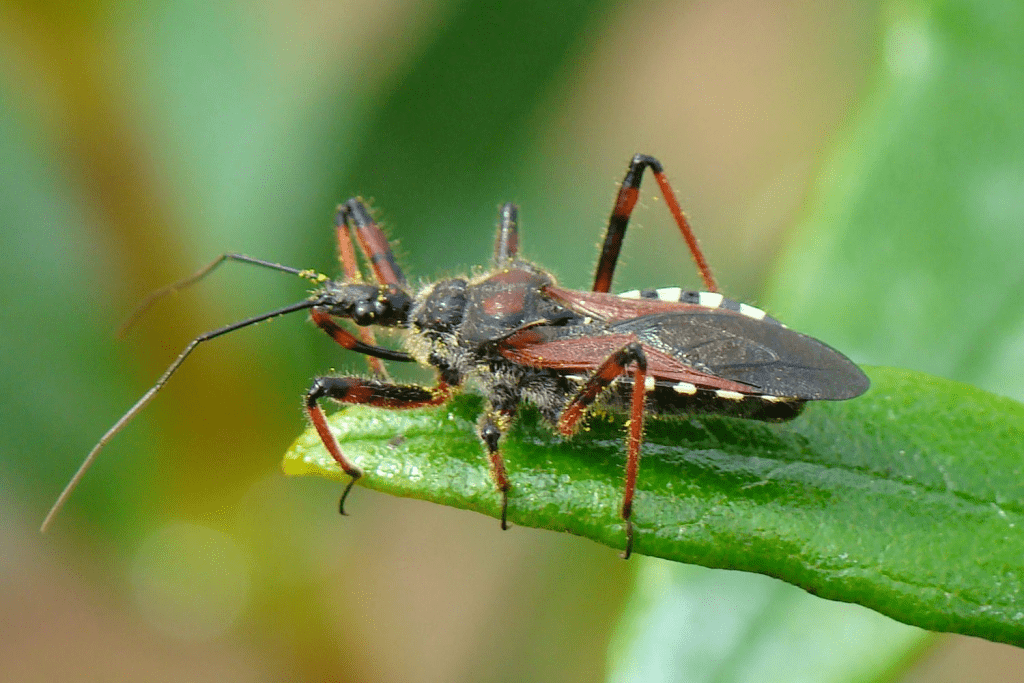As the weather cools, certain bugs start creeping into homes and gardens, seeking refuge from the chilly air. Among these are the notorious assassin bugs, known for their painful bites and potential health risks. Here, we’ll explore what makes these fall invaders unique, how to recognize them, and, most importantly, what to do if you get bitten.
Identifying Assassin Bugs: What Do They Look Like?

Assassin bugs belong to the Reduviidae family, boasting around 7,000 species worldwide. With their elongated heads, narrow necks, and distinctive curved proboscises, they’re built to hunt, feeding on other insects by piercing them and sucking out their bodily fluids. In terms of color, assassin bugs vary from brown to black, often with camouflage markings. They range from a few millimeters to over an inch in length, with flattened abdomens and some having armor-like thoraxes.
- Wheel Bug: This species has a saw-like thorax and is one of the most common assassin bugs in North America.
- Masked Hunter: Known for its dusty, debris-covered body, the masked hunter blends into its surroundings, making it hard to spot.
Where Assassin Bugs Hide: Common Fall Habitats
Assassin bugs are opportunistic hunters, thriving in a variety of settings. Here are some of their favorite places:
- Outdoors: They’re often found under rocks, logs, or piles of leaves. Forests, gardens, and fields are all prime locations.
- Indoors: As temperatures drop, assassin bugs may seek shelter in homes. They can lurk in cracks, crevices, and secluded spots, often entering through gaps in windows, doors, or walls.
These insects gravitate toward areas with ample food sources, like caterpillars, beetles, and other small insects. If you notice an influx of these bugs indoors, there’s likely an abundant food supply nearby.
What Happens If You Get Bitten? Signs of an Assassin Bug Bite
An assassin bug bite feels like a sharp, stabbing sensation and can be incredibly painful. After the initial bite, you may notice:
- Pain and Redness: The bite site may swell and turn red, often feeling warm to the touch.
- Itching and Swelling: Some individuals experience intense itching and swelling.
- Severe Reactions: In rare cases, assassin bugs can transmit Chagas disease, leading to fever, fatigue, nausea, and swelling beyond the bite area.
While most bites are simply uncomfortable, certain symptoms can indicate a more severe reaction. Be on the lookout for fever, dizziness, and other flu-like symptoms, especially if you live in an area where Chagas disease is common.
What to Do If an Assassin Bug Bites You: Essential First Aid Steps
If bitten, taking quick action can make a difference. Here’s how to manage the bite:
- Clean the Area: Wash the bite thoroughly with soap and water to prevent infection.
- Apply a Cold Compress: Use ice or a cold compress on the bite site to reduce swelling and numb the pain.
- Take Antihistamines: Over-the-counter antihistamines can help alleviate itching and swelling.
- Pain Relief: Use acetaminophen or ibuprofen to manage pain. Avoid scratching the area, as this could cause irritation or infection.

It’s essential to monitor the bite for a few days, watching for any worsening symptoms or signs of infection, such as increased redness, warmth, or pus.
When to Seek Medical Attention
Most assassin bug bites don’t require medical intervention, but there are times when it’s crucial to see a healthcare provider:
- Severe Allergic Reactions: Difficulty breathing, swelling beyond the bite area, or rapid heartbeat.
- Signs of Infection: If the bite site becomes increasingly red, warm, or develops pus.
- Symptoms of Chagas Disease: While rare, if you suspect the bug was a vector for Chagas disease and you experience fever, fatigue, or other related symptoms, consult a doctor immediately.
Preventing Assassin Bug Bites: Practical Tips
Keeping assassin bugs at bay is the best way to avoid bites altogether. Here’s what you can do:
- Wear Protective Clothing: When in areas where assassin bugs may be present, wear long sleeves, pants, and closed shoes.
- Use Insect Repellent: Apply insect repellent to exposed skin and clothing.
- Seal Your Home: Check for cracks in windows, doors, and walls, sealing any gaps where bugs might enter.
- Exercise Caution Outdoors: Be mindful when handling firewood, rocks, and other items where bugs might hide.
Protecting Your Home and Garden from Assassin Bugs

Keeping your environment clean and well-maintained can discourage assassin bugs from hanging around. Here are some strategies:
- Regular Cleaning: Indoors, clear out any clutter, especially in places where bugs could hide, like basements or attics. Outside, remove leaf litter, brush piles, and any debris.
- Manage Pests: Since assassin bugs feed on other insects, reducing their food sources can keep them away. Regularly check for and eliminate pests.
- Install Screens: Make sure windows and doors are screened to prevent any bugs from entering your home.
Assassin bugs are beneficial in controlling pest populations, so it’s possible to coexist with them in outdoor settings. However, taking these precautions can help limit their presence indoors.
Conclusion: Protect Yourself from Fall’s Hidden Bugs
Assassin bugs may seem like a small threat, but their bites can pack a punch, leading to pain, discomfort, and, in rare cases, serious health issues. By knowing how to identify them, where they hide, and what to do if bitten, you can reduce the risks. And by taking a few preventive measures, you can keep your home and garden safe from these stealthy predators. Stay aware and prepared to enjoy a bug-free fall season!


